The Right Way to Fall
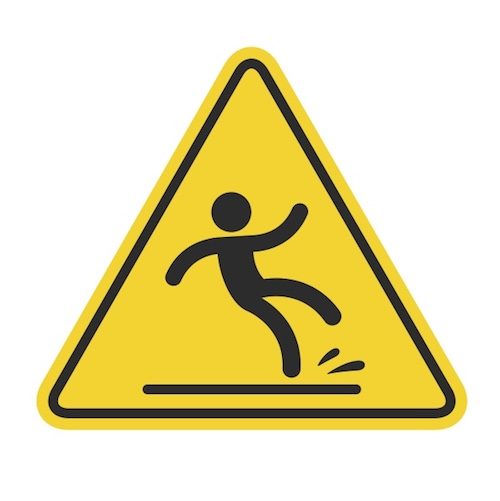
Falls are one of life’s great overlooked perils. We fear terror attacks, shark bites, Ebola outbreaks, and other minutely remote dangers, yet over 646,000 people die worldwide each year after falling. Falls are the second leading cause of death by injury, after car accidents. In the United States, falls cause 32,000 fatalities a year (more than four times the number caused by drowning and fires combined). Nearly three times as many people die in the U.S. after falling as are murdered by firearms.
Falls are even more significant as a cause of injury. More patients go to emergency rooms in the U.S. after falling than from any other form of mishap, according to the Centers for Disease Control and Prevention (CDC), more than twice the number injured by car accidents. The cost is enormous. As well as taking up more than a third of ER budgets, fall-related injuries often lead to expensive personal injury claims. In one case in an Irish supermarket, a woman was awarded 1.4 million euros [approximately $1.6 million] compensation when she slipped on grapes inside the store.
It makes sense that falls dwarf most other hazards. To be shot or get in a car accident, you first need to be in the vicinity of a gun or a car. But falls can happen anywhere at any time to anyone.
The most dangerous spots for falls are not rooftops or cliffs, but the low-level interior settings of everyday life: shower stalls, supermarket aisles, and stairways. Any fall, even a tumble out of bed, can change life profoundly, taking someone from robust health to grave disability in less than one second.
Falling can cause bone fractures and, occasionally, injuries to internal organs, the brain, and the spinal cord. “Anybody can fall,” says Elliot J. Roth, co-medical director of the patient recovery unit at the Shirley Ryan AbilityLab in Chicago. “And most of the traumatic brain injury patients and spinal cord injury patients we see had no previous disability.”
There is no Journal of Falls, though research into falling, gait, and balance has increased tremendously over the past two decades. Advances in technology improve our understanding of how and why people fall, offer possibilities to mitigate the severity of falls, and improve medicine’s ability to treat those who have hurt themselves falling.
Scientists are now encouraging people to learn how to fall to minimize injury — to view falling not so much as an unexpected hazard to be avoided but as an inevitability to be prepared for.
You can trip or slip when walking, but someone standing stock still can fall too — because of a loss of consciousness, vertigo, or something supposedly solid giving way. However it happens, gravity takes hold and a brief violent drama begins. And like any drama, every fall has a beginning, middle, and end.
“We can think of falls as having three stages: initiation, descent, and impact,” says Stephen Robinovitch, a professor in the School of Engineering Science and the Department of Biomedical Physiology and Kinesiology at Simon Fraser University in British Columbia, Canada. “Most research in the area of falls relates to ‘balance maintenance’ — how we perform activities such as stand- ing, walking, and transferring without losing balance.”
By transferring, he means changing from one state to another: from walking to stopping, from lying in a bed to standing, or from standing to sitting in a chair. “We have found that falls among older adults in long-term care are just as likely to occur during standing and transferring as during walking,” says Robinovitch, who installed cameras in a pair of Canadian nursing homes and closely analyzed 227 falls over three years.
Only 3 percent were due to slips and 21 percent due to trips, compared to 41 percent caused by incorrect weight shifting — excessive sway during standing or missteps during walking. For instance, an elderly woman with a walker turns her upper body, and it moves forward while her feet remain planted. She topples over due to “freezing,” a common symptom of Parkinson’s experienced regularly by about half of those with the disease.
In general, elderly people are particularly prone to falls because they are more likely to have illnesses that affect their cognition, coordination, agility, and strength. “Almost anything that goes wrong with your brain or your muscles or joints is going to affect your balance,” says Fay Horak, professor of neurology at Oregon Health & Science University.
Fall injuries are the leading cause of death by injury in people over 60, Horak says. Every year, about 30 percent of those 65 and older living in senior residences have a fall, and when they get older than 80, that number rises to 50 percent. A third of those falls lead to injury, according to the CDC, with 5 percent resulting in serious injury. It gets expensive. In 2012, the average hospitalization cost after a fall was $34,000.
How you prepare for the possibility of falling, what you do when falling, what you hit after falling — all determine whether and how severely you are hurt. And what condition you are in is key. A Yale School of Medicine study of 754 over-70s, published in the Journal of the American Medical Association in 2013, found that the more serious a disability you have beforehand, the more likely you will be severely hurt by a fall. Even what you eat is a factor: A study of more than 12,000 elderly French people in 2015 found a connection between poor nutrition and falling or being hurt in falls.
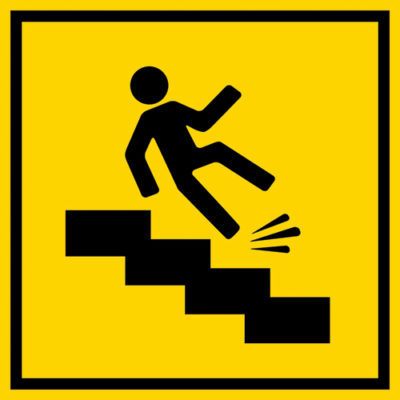
“Over one-half of older adults who fall are unable to rise independently, and are at risk for a ‘long lie’ after a fall, especially if they live alone, which can greatly increase the clinical consequences of the falls,” Robinovitch says. He and his colleagues are working to develop wearable sensor systems that detect falls with high accuracy, as well as providing information on their causes, and on near-falls.
Not that a device needs to be high-tech to mitigate falls. Wrestlers use mats because they expect to fall; running backs wear pads. Given that a person over 70 is three times as likely to experience a fatal fall as someone younger, why don’t elderly people generally use either?
The potential benefit of cushioning is certainly there. e CDC estimates that $31 billion a year is spent on medical care for over-65s injured in falls — $10 billion for hip fractures alone (90 percent of which are due to falls). Studies show that such pads reduce the harmful effects of falling.
But older people have all the vanity, inhibition, forget fulness, wishful thinking, and lack of caution that younger people have, and won’t wear pads. More are carrying canes and using walkers than before, but many more who could benefit shun them because, to them, canes and walkers imply infirmity. This sets up another vicious cycle related to falling: Fearing the appearance of disability, some elderly people refuse to use canes, thereby increasing their chances of falling and becoming disabled.
One unexpected piece of anti-fall technology is the hearing aid. While the inner ear’s vestibular system is maintaining balance, sound itself also seems to have a role.
“We definitely found that individuals with hearing loss had more dificulty with balance and gait and showed significant improvement when they had a hearing aid,” says Linda Thibodeau, a professor at the University of Texas at Dallas’s Advanced Hearing Research Center, summarizing a recent pilot study. “Most people don’t know about this.”
Thibodeau says one reason it’s important to establish this link is that insurance companies don’t typically cover hearing aids, because they are seen as improving lifestyle more than sustaining basic health. Hearing aids can be expensive — up to $4,000 each — but a broken hip, which insurance companies do cover, can cost 5 or 10 times that figure or more and lead to profound disability or death.
Nearly half of people in their 70s have hearing loss but typically wait 10 to 20 years beyond the time when they could first benefit before they seek treatment. If the connection to balance and falls were better known, that delay might be reduced.
Given the tremendous cost of falls to individuals and society, and the increasing knowledge of how and why falls occur, what can you do to prevent them? And can you do anything to lessen harm in the split second after you start to fall?
1. Prepare Your Environment
Secure loose rugs or get rid of them. Make sure the tops and bottoms of stairs are lit. Clean up spills immediately. Install safety bars in showers and put down traction strips, and treat slick surfaces such as smooth marble floors with anti-slip coatings. If there’s ice outside your home, clear it and put down salt.
2. Fall-Proof Your Routine
Watch where you are going. Don’t walk while reading or using your phone. Always hold handrails — most people using stairways do not. Don’t have your hands in your pockets, as this reduces your ability to regain your balance when you stumble. Remember that your balance can be thrown off by a heavy suitcase, backpack, or bag.
Roth asks most of his patients who have fallen to describe in detail what happened. “Sometimes people are not paying attention. Multitasking is a myth, and people should try very hard to avoid multitasking. No texting while walking.”
3. Improve Your Gear
Wear good shoes with treads. On ice, wear cleats — you can buy inexpensive soles with metal studs that slip over your shoes. Do not wear high heels, or at least have a second pair of flat shoes for walking between locations. Get a hearing aid if you need one. Wear a helmet when bicycling, skiing, and skateboarding. Use a cane or walker if required. Hike with a walking stick.
4. Prepare Your Body
Lower body strength is important for recovering from slips, upper body strength for surviving falls. Martial arts training can help you learn how to fall. Drugs and alcohol are obviously a factor in falls — more than half of adult falls are associated with alcohol use — as is sleep apnea. Get a balanced diet to support bone density and muscle strength. If you feel light-headed or faint, sit down immediately. Don’t worry about the social graces; you can get back up once you’ve established you are not going to lose consciousness.
Understandably, some elderly people fear falling so much that they don’t even want to contemplate it. “People should know they could improve their balance with practice, even if they have a neurological problem,” Horak says.
5. Fall the Right Way
What happens once you are falling? Scientists studying falling are developing “safe landing responses” to help limit the damage from falls. If you are falling, first protect your head — 37 percent of falls by elderly people in a study by Robinovitch and colleagues involved hitting their heads, particularly during falls forward. Fight trainers and parachute jump coaches encourage people to try not to fall straight forward or backward. The key is to roll, and try to let the fleshy side parts of your body absorb the impact.
“You want to reach back for the floor with your hands,” says Chuck Coyl, a theatrical fight director out of Chicago, describing how he tells actors to fall on stage. “Distribute the weight on the calf, thigh, into the glutes, rolling on the outside of your leg as opposed to falling straight back.”
Young people break their wrists because they shoot their hands out quickly when falling. Older people break their hips because they don’t get their hands out quickly enough. You’d much rather break a wrist than a hip.
Neil Steinberg is a columnist on staff at the Chicago Sun-Times. He has written for Esquire, Rolling Stone, Forbes, The Washington Post, and many other publications.
This article is featured in the January/February 2018 issue of The Saturday Evening Post. Subscribe to the magazine for more art, inspiring stories, fiction, humor, and features from our archives.
Adapted from the original article first published by Wellcome on Mosaic and is republished here under a Creative Commons license.
Waterfall Wonders
Even putting aside iconic Niagara Falls, America abounds with some of the world’s most captivating cascades, many just steps from parking. Now’s a perfect time for a road trip, as autumn leaves approach full color. Here are a few to consider:
Michigan
Named for a local native tribe, the 30-foot overfalls called Potawatomi Falls is considered one of the most picturesque along the National Black River Scenic Byway. Nearby Gorge Falls furrows through a narrow conglomerate canyon before briskly dropping 34 feet.
A thrilling display of wild twisting and churning, The Black River’s Rainbow Falls, named for the abundance of prismatic rainbows in its rising mist, is the final plunge before the river empties into Lake Superior.
Porcupine Mountain’s Presque Isle River drops through Nawadaha Falls and Manido Falls and then rushes into an expanse of churning whitewater before hitting Manabezho Falls, a myriad of chutes charging 20 feet down a craggy dark boulder.
Deep within the Ottawa National Forest, a boardwalk provides routes to six scenic viewing locations overlooking Bond Falls’ series of short drops, ultimately converging into a 100-foot-wide cascade flowing over 40 feet of volcanic rock.
Located within the Munising city limits, along the Pictured Rocks National Lakeshore, a paved 800-foot trail guides visitors into a shaded sandstone canyon at the base of Munising Falls’ 50-foot drop, where tannins and moss tint the swirling water amber and hazel. The powerful water force that feeds into 50-foot Miners Falls funnels inside a crevice of converging rocks, allowing close-up glimpses from the upper platform without encountering too much spray. Sable Falls cascades 75 feet over three tiers of sandstone cliffs before spilling into Lake Superior.
Buried deep within a 50,000-acre state park bearing its name, amber-tinged Tahquamenon Falls encompasses two sets of falls; its upper falls span 200 feet across with a 50-foot drop, dumping about 50,000 gallons of water per second at peak. The equally spectacular lower falls comprise five smaller cascades surrounding a small island.
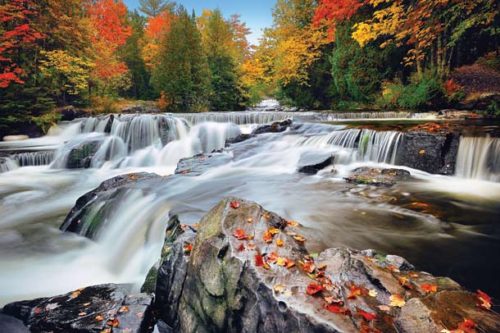
Oregon
The first of the falls along the Columbia River Scenic Highway, two-tiered Latourell Falls, is most renowned for its lower falls — an uncurving 249-foot linear stream gushing from a basalt cliff outcrop.
Shepperd’s Dell Falls is a 92-foot, two-tiered waterfall washing through a bucolic canyon. From the top, the water drops 42 feet and then roars down a 50-foot plunge into Youngs Creek before streaming into the Columbia River.
Touted as the most scenic waterfalls along the highway, the multi-tiered, 242-foot Wahkeena Falls (meaning “most beautiful” in Yakama) is acclaimed for its alluvial fan formation, patterning various veins of a raging river cascading over the ridge.
Dropping 176 feet into a pool along the roadside, Horsetail Falls forms the shape of an equine tail.
At 635 feet, Multnomah Falls is Oregon’s tallest waterfall. Rapids here plunge from two tiers measuring 542 feet and 69 feet, with a small downhill rapids in between.
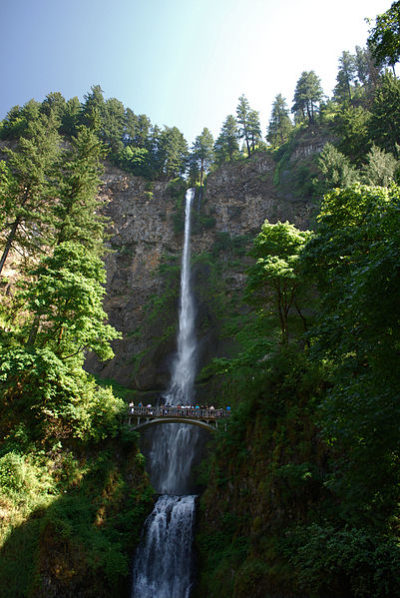
North Carolina
The area around the Blue Ridge Parkway near Asheville, North Carolina, offers a large number of cascades to take in.
The 60-foot-tall Looking Glass Falls is the gushing gem of the Pisgah National Forest. Its easy roadside access welcomes early-bird revelers who arrive to marvel at the sunrise over the falls, illuminating the surrounding autumn hues.
Residing upon the sacred grounds of the Cherokee Nation, Soco Falls flows from a series of smaller falls at the confluence of two creeks splashing 50 feet down onto moss-covered rocks below.
Only viewable from an adjacent mountain ridge, Glassmine Falls flows only after a heavy rain, plunging from a remote and inaccessible cliff top within Ashville’s watershed.
You’ll catch a glimpse of Toxaway Falls in Gorges State Park from above while driving across a scenic highway viaduct. Park and follow the ridgetop walkway for views of the water splashing over multiple tiers of intensely hued bedrock from its namesake lake above.
Bridal Veil Falls, the first of four waterfalls on Little River, was featured in the movies The Hunger Games and The Last of the Mohicans. Visitors can walk or drive beneath a ledge of the first cascade.
A short trail leads behind Dry Falls’ powerful plummets, providing visitors misty views of the surrounding autumn hues while remaining dry.
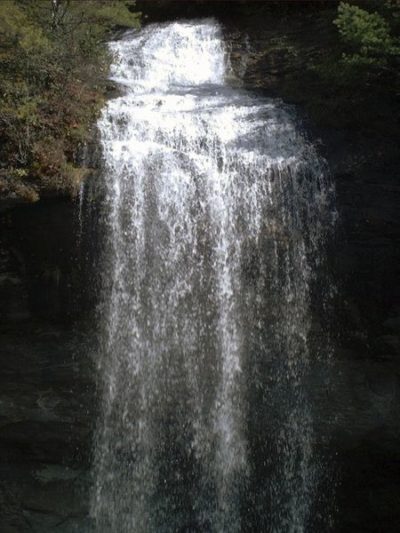
A short trail leads behind Dry Falls’ powerful plummets, providing visitors misty views of the surrounding autumn hues while remaining dry.
An abridged version of this article is featured in the September/October 2017 issue of The Saturday Evening Post. Subscribe to the magazine for more art, inspiring stories, fiction, humor, and features from our archives.